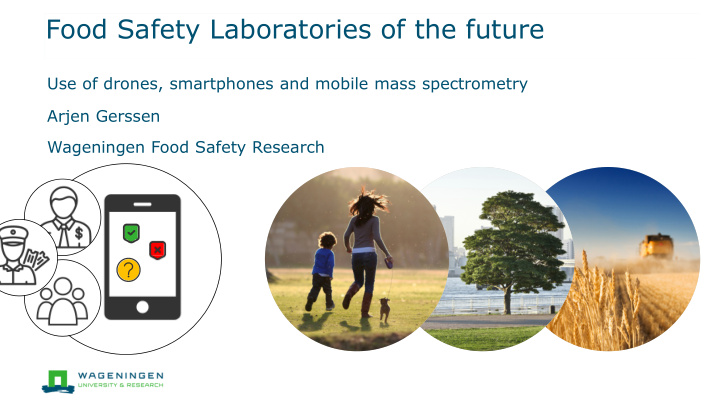



Food Safety Laboratories of the future Use of drones, smartphones and mobile mass spectrometry Arjen Gerssen Wageningen Food Safety Research
So imagine.... WFSR Tools for safety and quality control Production Transport Consumers Inspection and Control Retail Storage Circular economy 2
Current changes On-site sampling Administration Transportation Lab Screening Few % suspects Lab Confirmation <1% non-compliant 3
Current changes On-site sampling On-site sampling & Pre-screening Administration Few % suspects Paradigm Transportation shift Lab Screening Administration Transportation Few % suspects Lab Confirmation Lab Confirmation Non-compliant <1% non-compliant 4
So imagine.... Tools for safety and quality control 5
Tools for safety and quality control The role of WFSR We’re not machine builders [smartphones, camera’s and equipment (i.e. mass spectrometers)] Collaborate with machine builders (give constraints and α and β testers) Hyphenate existing and new technologies Apply them in our area of research (Food and Feed Safety) Bring them to the applicants 6
Drones Precision farming Delivering goods / services Remote sensings 7
Drones and remote sensing 8
Drones and remote sensing (electrochemical) Metal Oxide (MOx) sensors Creating a chemical fingerprint and combine with chemometric modelling (machine learning) 9
Drones and remote sensing Classification model various types of fires Prediction towards potential food safety problems (PAHs, PCBs and Dioxins) Remote sampling 10
Smartphones Biochemical recognition elements Ultra-fast biorecognition Optical detection using smartphone camera Electrochemical detection via portable potentiostat 3D printed microfluidics Robustness and ease of use Software, server and cloud interfacing App development 11 This project has received funding from the European Union’s Horizon 2020 research and innovation programme under the Marie Sklodowska-Curie grant agreement No 720325
Smartphones and LOC 3D printed manifold Pre-contained reagents No pipetting skills Finger pumps 12 Suska, A et al., Sci Rep 9, 20320 (2019). https://doi.org/10.1038/s41598-019-55111-z
Smartphones and allergen detection Applicability of assay – Hazelnut allergens in cookies ● Allergen LFIA featuring carbon NP labelled secondary mAbs ● Record-breaking assay speed (30s! for test line development) 13 Ross, G.M et al., Biosensors 8 , 130 (2018). https://doi.org/10.3390/bios8040130
Smartphones and allergen detection Read-back by smartphone Quantitative More reliable 14 Ross, G.M et al., Biosensors 8 , 130 (2018). https://doi.org/10.3390/bios8040130
Spectral techniques 15 This project has received funding from the European Union’s Horizon 2020 research and innovation programme under the grant agreement No 732541
Spectral techniques (chemometric models) 16 Weesepoel Y. et al., Journal of AOAC INTERNATIONAL (2020) https://doi.org/10.1093/jaoacint/qsaa099
Spectral techniques Adulteration of Extra Virgin Olive Oil (EVOO) Data fusion 17 Weesepoel Y. et al., Journal of AOAC INTERNATIONAL (2020) https://doi.org/10.1093/jaoacint/qsaa099
Spectral techniques (NIR) On-site Drug testing (cocaine) handheld near ‐ infrared spectrometer and machine learning algorithms (A) Cocaine HCl (86.6%) sample (13 scanner 5 spectra each) (B) Cocaine HCl (green line) and adulterated cocaine (red line) 18 Kranenburg R.F. et al., Drug Testing and Analysis 12(10), 1404-1418 (2020) https://doi.org/10.1002/dta.2895
(Trans)portable lab equipment Screening Confirmation Transportable Transportable Portable Multiplex assay Mass spectrometry Mass spectrometry (biorecognition) Weight of vacuum systems, power and gas supplies, high voltage etc.: serious engineering challenges! Easy to operate, WiFi, low weight, libraries Preferably MS/MS analyzers 19
(Trans)portable lab equipment - Luminex On-site application for shellfish industry to check for the presence of multiple toxins Toxin Measurement Reporter Antibody Magnetic beads with ‘toxines’ magnet magnet 20
(Trans)portable lab equipment Current workflow in a laboratory Extraction Chromatography Ionization Mass Spectrum Samples Workflow for on-site analysis Mass Spectrum Samples Ionization Direct sample Introduction 21
Transportable lab equipment (MS) 4 1 2 3 22 Jager J. et al., J. Am. Soc. Mass Spectrom. (2020) https://doi.org/10.1021/jasms.0c00307
Patent pending 23
Portable lab equipment (MS) No external power or gas supply needed Operational within 10 minutes Simplified read-out for non-technician 24
Portable lab equipment (MS) Evaluation for on-site fraud detection with spices ● Adulterated pepper 25
Portable lab equipment (MS) TIC real pepper Aromadendrene Limonene 91 67 100 100 93 79 105 133 79 53 77 53 69 91 55 161 50 77 50 67 81 119 121 189 136 65 147 51 65 107 95 205 55 105 63 176 89 158 102 0 0 50 60 70 80 90 100 110 120 130 140 150 160 170 180 190 200 210 50 60 70 80 90 100 110 120 130 140 150 TIC adulterated pepper 26
Challenges Validation and accreditation ● Quality assurance Consumer behaviour when using these tools Technical improvements needed ● portable MS/MS for selectivity / sensitivity View on the classical laboratories should be changed 27
Conclusion 2016 2030 High-end laboratories Classical laboratories ‘Personalized’ ‘on-site’ ‘citizen science’ 28
So be prepared! Your lab Tools for safety and quality control Production Transport Consumers Inspection and Control Retail Storage Circular economy 29
Funding Acknowledgement Sandra Munniks Yannick Weesepoel This project has received funding from the European Union’s Horizon 2020 research and innovation programme under the grant agreement No 732541 Marco Blokland Michel Nielen This project has received funding from the European Union’s Horizon 2020 research and innovation programme under the Marie Sklodowska-Curie grant agreement No 720325 Arjen.Gerssen@wur.nl TKI LWV244, with the title: “Point of Need Testing (PoNT) for transparent, sustainable production chains”. Ministry of Agriculture, Nature and Food Quality - Project KB-37-002-005 Innovative tech development chromatography and mass spectrometry - Project KB-37-002-018 Fast On-site method development 30
Recommend
More recommend